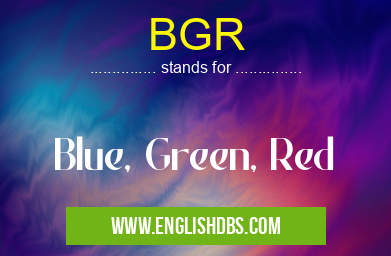What does BGR mean in COLORS
BGR is an acronym that stands for Blue, Green, and Red. It is used in the field of computer science to refer to how color is represented in a digital image. Specifically, BGR refers to the three primary colors (blue, green, and red) that can be used to create a digital image on a computer monitor or other display device. In this context, BGR is often used interchangeably with the terms RGB (red, green, blue) and CMYK (cyan, magenta, yellow, black).

BGR meaning in Colors in Miscellaneous
BGR mostly used in an acronym Colors in Category Miscellaneous that means Blue, Green, Red
Shorthand: BGR,
Full Form: Blue, Green, Red
For more information of "Blue, Green, Red", see the section below.
» Miscellaneous » Colors
Meaning of BGR
BGR stands for the three primary colors – blue, green, and red – that are used to create a digital image on a computer monitor or other display device. By combining these three colors in various ways using light intensity values from 0 to 255 (for each channel), it’s possible to create any color visible on most monitors. Furthermore, by changing the values of these primary colors when manipulating a digital image or graphic item it’s possible to change its hue and saturation levels in order to adjust the intensity and appearance of those objects.
Applications of BGR
The application of BGR is seen in many areas within computer graphics technology such as photo editing software programs like Adobe Photoshop or GIMP. Here you can use sliders or selection tools to adjust individual red/green/blue channels of an image allowing you more control over how it appears on-screen. This technique is also widely applied within HTML coding where developers may override specific colors using hexadecimal notation set against an individual RGB value. For example #FF0000 would represent full red whereas #00FF00 would represent all-green output from within HTML documents.
Essential Questions and Answers on Blue, Green, Red in "MISCELLANEOUS»COLORS"
What does BGR stand for?
BGR stands for Blue, Green, Red. It is an acronym used to identify the three primary colors in a color spectrum.
How does BGR differ from RGB?
BGR and RGB are both acronyms that are used to identify and order the three primary colors in a color spectrum. The only difference is that BGR orders the colors as Blue, Green, Red while RGB orders them as Red, Green, Blue.
Why is BGR important?
BGR is important because it is often used in digital imaging to define a range of colors within an image or video. By using different combinations of blue, green and red pixels of varying intensities, vivid calls can be created and displayed.
What technology uses BGR?
Many types of computer vision technologies such as facial recognition and object detection use BGR to enhance their accuracy and improve results. Additionally, many computer graphics programs use it for image manipulation and color adjustment.
Is there a difference between digital and analog formats of the RGB/BGR color system?
Yes, there is a slight difference between digital and analog versions of the RGB/BGR system due to how each format encodes its information. With digital formats like PNGs or JPGs the information is stored as immutable values whereas with analog formats like CRTs or LCDs each pixel has an ever-changing intensity value which creates a more accurate picture but at higher power cost.
What kind of graphics programs use the BGR color system?
Adobe Photoshop, Corel PaintShop Pro, GIMP, Inkscape and other popular image editing software all use some variation of the BGR color system in order to help artists manipulate their work quickly and efficiently.
How do you convert an image from one color system (BGR) to another (RGB)?
Converting an image from one format (BGR) to another (RGB) typically requires some basic understanding of photo editing software first. Once you have opened up your desired file in Photoshop or any compatible software you'll need to navigate to File > Export > Convert To... From here you can choose whatever output file type you'd like (e.g.,.jpg or.png) as well as select RGB from the Color Profile dropdown menu before finally hitting Save!
Can I view two different images side by side using BGR instead of RGB?
Yes! While most viewers employ the RGB format by default there are still plenty out there that allow users to view two images side-by-side using any combination of successful output modes including grayscale for brightness adjustments or even just flipping between both photos' natural colorspaces (like switching between natural RBG & inverted versions). To do this simply open up your favorite photo viewer and toggle your settings accordingly before dragging-and-dropping your desired files into place!
Final Words:
To sum up, BGR stands for Blue Green Red and is commonly used in computer graphics technology as well as web development when controlling color output across multiple displays or devices. By taking advantage of an 8-bit 256 range from 0-255 per channel it’s possible to create thousands of different hues with just these three primary colors making them incredibly useful tools when creating anything from photographs through to websites. Further applications may include gaming as well as 3D modeling where lighting sources need precise control over their beam manipulation.
